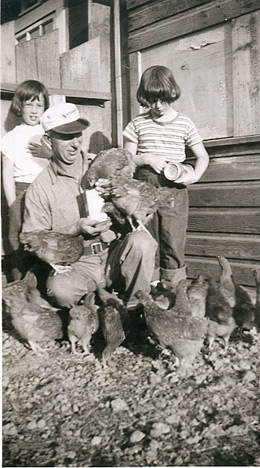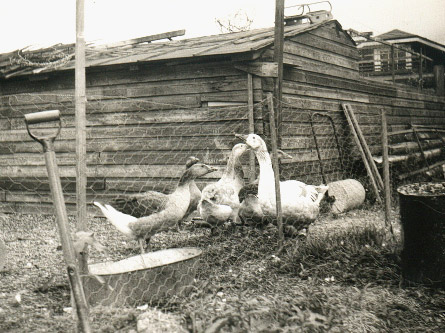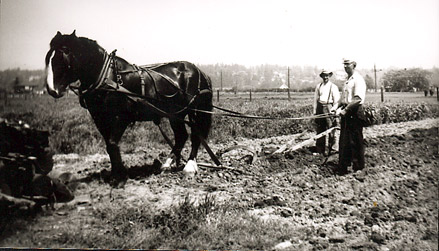Growing up with Chickens, Geese, Turkeys and Rabbits
By Sharon Slack
City Farmer's Head Gardener, Vancouver BC
aquastar@telus.net

Photo Caption: Nancy, Dad and me with young hens (pullets) on Blenheim Street between 55th and Celtic Avenue - early 1950s.
I grew up in Southlands, between SW Marine Drive and the North Arm of the Fraser River. In those days, it was called the Blenheim Flats, and I still refer to the area as "the Flats" (This was before the area was 'gentrified' with monster houses).
I lived there from 1945 until 1962. We initially lived in one of the houses at the waterfront (Celtic Slough) that had belonged to the Japanese fishermen and their families before they were interned. While there, an uncle gave Nancy (my sister) and me each a pair of rabbits - New Zealand Giants. And giants they turned out to be! Dozens of them! We ate a lot of rabbit in those days.
The City decided to demolish those houses in 1948, so we bought an acre, half a block up Blenheim Street. We had chickens for most of the next ten to twelve years. We also had turkeys one year, and geese for a few years. The first two geese were named Bruce and Alice. Nancy and I named them. Mom made sure we were not around when they were finally butchered. Geese can be quite aggressive, especially if they have goslings. However, one day we found our dog Sandy, (Shepherd/Collie cross) lying in the pen with about a dozen goslings crawling all over her and Alice (the sweet) was not upset about it!
The turkeys were more trouble than they were worth. They were prone to disease, needed pills to stay healthy and had to live off the ground. The geese were great for eating, but their eggs were hard to open and Mom had to alter her recipes ... one egg was about 3/4 of a cup!
 Photo Caption: 1950's. Parent geese in front. Alice (grey) submissive. Bruce (white) aggressive. Goslings in back (2 months old). Building behind housed chickens and geese.
Photo Caption: 1950's. Parent geese in front. Alice (grey) submissive. Bruce (white) aggressive. Goslings in back (2 months old). Building behind housed chickens and geese.
The chickens were not the smartest creatures, however they were reasonably reliable for producing eggs and meat. We had Rhode Island Reds. My Dad butchered the birds, not a pleasant task, and I had to do the plucking. It is easier if hot water is poured over the carcass first. Mom did the cleaning of the birds and preparing them for roasting or freezing. We kept a rooster and that enabled us to have a couple of broods of chicks a year.
As hens often go off the lay in the winter, my Dad had lights in the chicken house and Mom fed them hot food when it was cold to encourage them to keep laying. Mom kept a large pot on the back of our wood stove, simmering all day long. It had a strange smell. She put in all her vegetable and fruit trimmings, bread crusts, all left overs, and some laying mash. The chickens really liked it!
As soon as spring came, we opened a little door in the back of the outdoor chicken run, and let them out into the field (fenced) behind the shed. This gave them a chance to do some serious scratching to find bugs, and eat lots of fresh greens. This is what gives the eggs a nice orange yolk.
We usually had a flock of about 2 dozen birds. The hen house was about 6 feet by 15 feet. There were perches for roosting, and nest boxes for laying eggs. We had sawdust for bedding on the floor, to keep their feet dry in winter. The outside run was about 15 by 20 feet.
Their manure went on to our large garden. We grew most of our veggies in those days, and some apples, pears, blueberries, strawberries.
Growing up on the Blenheim Flats (now Southlands) in Vancouver, BC in the 1950's and 60's
By Sharon Slack
City Farmer's Head Gardener, Vancouver BC
aquastar@telus.net
Photo Caption: My dad, Fred Bain, plowing on the Blenheim Flats with Gerry Logan's horse "Prince". This field was later planted with Winter Rye. (1950's) Now Southlands, south foot of Blenheim Street.
 When I was a child growing up on the Flats, there were no 'monster'
houses, Our home was built at ground level, which was 3 feet below
sea level and we relied on the dyke to keep us dry. The ground was
reclaimed river land - very fertile (clay) soil, - which produced
great crops, especially root vegetables. The growing season was
shorter because of the high water table and the low altitude, but
once the soil dried out enough, we were able to grow most of our
veggies for the year.
When I was a child growing up on the Flats, there were no 'monster'
houses, Our home was built at ground level, which was 3 feet below
sea level and we relied on the dyke to keep us dry. The ground was
reclaimed river land - very fertile (clay) soil, - which produced
great crops, especially root vegetables. The growing season was
shorter because of the high water table and the low altitude, but
once the soil dried out enough, we were able to grow most of our
veggies for the year.
We grew about 1/4 of our acre in potatoes, which was our year's supply and we even had enough extra to sell. The potatoes, beets, winter squash, onions, and carrots were stored in the cold-room in the garage. Mom froze peas, beans, tomatoes, and corn. She pickled the cucumbers and some of the beets and canned pears. She also froze apples, rhubarb, and some blueberries. We ate broccoli, lettuce and strawberries fresh in season.
Nancy (my sister) and I didn't do much in the garden, but weeding all those potatoes was boring! We had a big lawn around the house so she and I did a lot of lawn mowing. We fed the chickens and collected the eggs and also helped with harvesting the potatoes in the fall.
On part of our acre, we grew a hay crop. My Dad borrowed Logan's horse, named Prince, and the hay-mow and hay-rake. When the hay wagon came, pulled by Prince and Queenie, a number of us kids got to ride around the Flats on top of the hay as we delivered it to a couple of neighbours who had cows. The rest of the hay went to Logan's farm, now the McCleery Golf Course.
More Stories from the Slacks
For more stories from Sharon and husband Terry about the early days in Vancouver, see The City of Vancouver Millennium Project. Click on "check them out!" and then in the search box, type one of "Sharon Slack", "Terry Slack" or "Leslie Slack". Wonderful stories and photos will appear titled: A Cat's Tale, The Big Fire!, The Earthquake! Barney's Store, Booming Grounds, Last Hope - Easthope, Puff and the Moontide, The Green Sturgeon, and Waiting for the Collector.
Sharon's Home Garden Today
![[new]](new01.gif)
